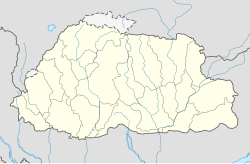Trongsa Dzong
| Trongsa Dzong Chhoekhor Raptentse Dzong Choetse Dzong |
|
|---|---|

Trongsa Dzong
|
|
|
|
|
| Coordinates | 27°29′58″N 90°30′17″E / 27.49944°N 90.50472°E |
| Monastery information | |
| Location | Trongsa, Trongsa district, Bhutan |
| Founded by | Ngagi Wangchuk (1543) |
| Founded | As a dzong by Shabdrung Ngawang Namgyal in 1647. |
| Date renovated | 1927, 1999-2008 |
| Type | Tibetan Buddhist |
| Sect | Drukpa |
| Number of monks | 200 |
| Architecture | Dzong |
Trongsa Dzong is the largest dzong fortress in Bhutan, located in Trongsa (formerly Tongsa) in Trongsa district, in the centre of the country. Built on a spur overlooking the gorge of the Mangde River, a temple was first established at the location in 1543 by the Drukpa lama, Ngagi Wangchuk son of Ngawang Chhojey. In 1647, his great-grandson Shabdrung Ngawang Namgyal (Shabdrung or Zhabdrung being his title), constructed the first dzong to replace it, called Chökhor Rabtentse Dzong with a shorter version of Choetse Dzong. It was enlarged several times during the 18th century; the Chenrezig Lhakang was built in 1715 and a whole complex, including the Maitreya (Jampa) temple, was added in 1771. The dzong has since been repaired on several occasions; it was damaged during the 1897 Assam earthquake and underwent extensive renovation in 1927 and 1999.
Trongsa Dzong, the largest dzong at a striking location, is an important administrative building, providing the headquarters of the government of Trongsa District. Trongsa provides a strategic central location to control Bhutan and for centuries it was the seat of the Wangchuck dynasty of penlops (governors) who effectively ruled over much of eastern and central Bhutan, and from 1907 have been Kings of Bhutan. It is also a major monastic complex, with around 200 monks. During the summer months, the monastic community often relocates to Kurje Monastery in the Bumthang Valley. It contains a notable printing house, responsible for the printing of many religious texts in Bhutan.). It is listed as a tentative site in Bhutan's Tentative List for UNESCO inclusion.
The Dzong and the small town surrounding it are situated on a spur, a wild rocky area, above the ravines of the Mangde Chuu valley with the scenic backdrop of the Black Mountains on its southwest. The Dzong is located above the fast flowing Mandge Chu in a unique setting that has been described as "the most spectacularly sited dzong in Bhutan with a sheer drop to the south that often disappears into cloud and mist".
...
Wikipedia

